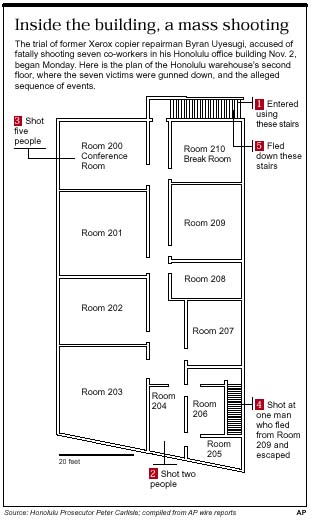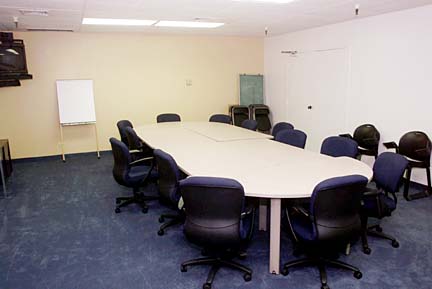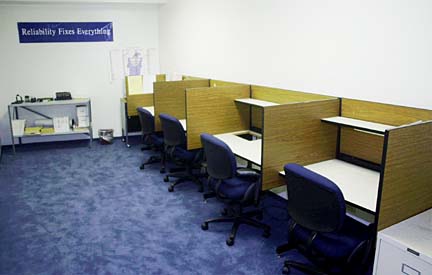Advertisement - Click to support our sponsors.

XEROX SHOOTINGS

Carlisle details
‘angry’ worker
The city prosecutor claims
The key players
that Byran Uyesugi killed
seven men 'deliberately,
methodically, maliciously'
Most in poll say Uyesugi guilty By Debra BarayugaStar-Bulletin
Nov. 2, 1999, was a day of opportunity for Xerox copy-machine repairman Byran Uyesugi.
That was the day the anger and hate that had festered throughout the years manifested itself.
That was the day he drove to his workplace at 1200 N. Nimitz Highway and went on a rampage with a semiautomatic handgun, killing seven male co-workers in Hawaii's worst multiple slaying.
And as the men lay on the floor "completely defenseless," Uyesugi shot them in the heart to make sure no one would survive, said city Prosecutor Peter Carlisle.
"He pumped 25 bullets into unarmed men and deliberately, methodically and maliciously became a mass murderer."
In opening statements today, Carlisle described why and how Uyesugi chose Nov. 2 as the day to vent his anger and hatred, and the disturbing incidents as early as in 1993 that led up to that day.
Click here for Quicktime
Click here for RealVideo
Download RealPlayer 7
Because of a scheduled work team meeting that morning, Uyesugi knew the people he was targeting for death would be present. "He decided who would die, who would live, when and where they would die and how they would die," Carlisle said.
By 8:15 a.m. that day, seven men had been killed.
The victims were Uyesugi's supervisor, Melvin Lee, and co-workers Jason Balatico, Ford Kanehira, Ronald Kataoka, Ron Kawamae, Peter Mark and John Sakamoto.
Carlisle described Uyesugi as a disgruntled, "problem" employee angry at his co-workers at Xerox because they were "messing with him" or trying to make him look bad and were looking for reasons to get rid of him.

He did not want Xerox to fire him and did not want to give his co-workers the satisfaction of seeing him get fired, Carlisle said.Uyesugi did not relate as well with his customers as his co-workers did. Some of his problems stemmed from his blaming customers and co-workers when the copy machines would not work as they were supposed to.
He would give people the stink eye or silent treatment if he was not happy with a job assignment. At work he would talk about his guns to co-workers as a way to intimidate them, Carlisle said.
Uyesugi also had a temper. Once, it led him to kicking in an elevator panel in 1993 after a confrontation with a customer, causing $1,000 to $2,000 damage.

That same year, he had a confrontation with a co-worker over the performance of a copy machine, later asking him, "You like beef?" He backed off when the co-worker told him they would both get fired if they did. But later he told other co-workers, "I'm going to have to kill that sucker."He also talked about other co-workers, including those who would die that November day, saying, "If I ever get fired, I'm going to bring my guns and kill as many employees as I can before going down."
After learning of the previous incidents, Xerox ordered him to undergo evaluation or be fired.

Doctors at Castle Hospital concluded that he suffered from a delusional disorder based on their examination and statements he made. Uyesugi told them there was a conspiracy at Xerox to get rid of him. He thought that the FBI and other federal people were following him and that there were bugs planted in his shower, bed and car.But more disturbing were his statements that his company "overreacted" over the elevator incident and his denial that he had ever threatened co-workers.
The doctors believed he was able to control himself and was not dangerous as a result of his mental illness, and he was released.

Before allowing him to return to work, Xerox made him agree in writing that he would not cause further trouble or hurt anyone and that any future threats or acts of violence would result in "immediate termination."An independent panel of doctors appointed by the court in January also unanimously concluded that Uyesugi suffers from a delusional order or schizophrenia.
More important, they found that he knew right from wrong and was capable of controlling his behavior according to the law at the time, Carlisle said.
Uyesugi's attorneys are expected to raise the defenses of insanity and extreme mental and emotional distress for which there is a reasonable explanation.
Two members of Uyesugi's family and at least six relatives of the seven victims were present in the courtroom today as Carlisle and the defense gave their opening statements. Uyesugi, wearing a blue print aloha shirt, sat quietly at the defense table and occasionally shuffled papers.
The key players
For the state
Peter Carlisle
CITY PROSECUTOR
Age: 47
Experience: Elected city prosecutor from 1997 to present; partner at Shim Tam Kirimitsu Kitamura & Chang from 1990 to 1996; deputy city prosecutor from 1978 to 1989.
Major cases: In State vs. Gabriel Kealoha, the defendant was convicted of manslaughter and sentenced to one year for the death of a drunken off-duty police officer on H-1. In State vs. James Steinseifer, the defendant was convicted of manslaughter and sentenced to 20 years, the longest drunken-driving sentence ever, for the deaths of two women and a baby. In State vs. Frank Janto, Janto was convicted of murder and given a 75-year prison term, the longest state sentence ever, for beating a woman and throwing her body into a trash bin.
Kevin Takata
ASST. PROSECUTOR
Age: 44
Experience:Deputy prosecuting attorney from 1987 to present; attorney with Oliver Cuskaden Lee Ogawa & Law.
Major cases: In State vs. Ventura Jorge Rivera-Rios, the defendant was convicted of murder and sentenced to life for killing a transvestite. In State vs. Enele Ili, the defendant was convicted of murder and sentenced to life for a gang-fight killing.
Chris van Marter
ASST. PROSECUTOR
Age: 39
Experience: Deputy prosecuting attorney from 1992 to present.
Major cases: In State vs. Ditto Rodrigues, the defendant was convicted of a drug-related murder and sentenced to 100 years, topping Janto's sentence as the state's longest. In State vs. Jamie Arenas, the defendant was convicted of murder and sentenced to life for killing his wife.
For the accused
Jerel Fonseca
DEFENSE ATTORNEY
Age: 46
Experience: Attorney and founder of the firm, Fonseca Mills and Ching, from 1987 to present; attorney with David Schutter from 1982 to 1987.
Major cases: Defended former Bishop Estate trustee Richard "Dickie" Wong and his former wife Mari Stone Wong. Criminal conspiracy charges related to a Bishop Estate land deal were dropped. He defended Mililani art teacher Brian Ibaan, who pleaded guilty to sexually molesting young girls and received 10 years in prison. He also defended Simeon Rojas in the "Baseball Bat Murder Case," in which Rojas was acquitted.
Rodney Ching
DEFENSE ATTORNEY
Age: 48
Experience: Worked for the Department of Commerce and Consumer Affairs; the city prosecutor's office; and David Schutter, before co-founding the firm, Fonseca Mills and Ching in 1987. He briefly left the firm and has since returned.
Major cases: Defended a number of clients on sexual assault, burglary, kidnapping and drug charges. He has never worked on a murder trial.
Most say Uyesugi
Poll also covered politicians' images, Ireland trial By Debra Barayuga
guilty of murder
Star-BulletinMost people aren't buying accused gunman Byran Uyesugi's probable use of the insanity defense.
Nearly four out of five respondents in a Honolulu Star-Bulletin/NBC Hawaii News 8 poll say Uyesugi, a Xerox copy-machine repairman, should be found guilty of murder, and not acquitted by reason of insanity for the deaths of seven co-workers.
Seven percent believed he should be acquitted. An additional 15 percent were not sure.

The telephone poll, conducted May 5-9 by Mason-Dixon Polling & Research Inc. of Washington, D.C., has a margin of error of plus or minus 5 percentage points.Uyesugi, 41, goes on trial today for first-degree murder, seven counts of second-degree murder and one count of attempted murder for the shooting spree at the Xerox building in November.
If convicted as charged, Uyesugi faces a mandatory life term without the possibility of parole. If acquitted by reason of insanity, Uyesugi will be committed to the Hawaii State Hospital until he is found fit to be released. He could stay there for life.
Defense lawyers, in raising the insanity defense, must prove that Uyesugi suffered from a mental disease, disorder or defect that affected his ability to know right from wrong and conform his conduct according to the law.
There was little difference in the poll between male and female responses: 77 percent of males and 79 percent of females believed that Uyesugi should be found guilty.
Xerox killings